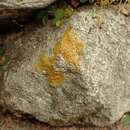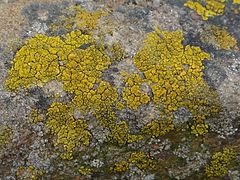en
names in breadcrumbs


Candelariella vitellina is a common and widespread green-yellow to orange-yellow crustose areolate lichen that grows on rock, wood, and bark, all over the world.[1] It grows on non-calcareous rock, wood, and bark.[1] It often has tiny lobate areoles in the shape of lion claws.[1] The areoles may be flat or convex.[1] Its sexual reproduction structures (apothecia) are a 0.35–1.0 mm-wide disc, darker yellow than the thallus, rimmed with thallus-like tissue lecanorine, flat but becoming convex with age.[1] Lichen spot tests are K+ reddish, KC−, and C−.[1] It produces calycin, pulvinic acid, pulvinic dilactone and vulpinic acid as secondary metabolites.[1]
In California, it prefers growing on granite, but can also be found on wood (rarely on bark) and other kinds of rock.[2]: 251
Candelariella vitellina looks like a miniature version of C. rosulans.[1] It can be distinguished by C. vitanela having a visible exciple (the rim around the apothecia disc), which C. rosulans does not have.[1] It is usually much larger and thicker than the similar C. lutella.[1]
It is a known host to the lichenicolous fungus species Carbonea vitellinaria.[3][4]
Candelariella vitellina is a common and widespread green-yellow to orange-yellow crustose areolate lichen that grows on rock, wood, and bark, all over the world. It grows on non-calcareous rock, wood, and bark. It often has tiny lobate areoles in the shape of lion claws. The areoles may be flat or convex. Its sexual reproduction structures (apothecia) are a 0.35–1.0 mm-wide disc, darker yellow than the thallus, rimmed with thallus-like tissue lecanorine, flat but becoming convex with age. Lichen spot tests are K+ reddish, KC−, and C−. It produces calycin, pulvinic acid, pulvinic dilactone and vulpinic acid as secondary metabolites.
In California, it prefers growing on granite, but can also be found on wood (rarely on bark) and other kinds of rock.: 251
Candelariella vitellina looks like a miniature version of C. rosulans. It can be distinguished by C. vitanela having a visible exciple (the rim around the apothecia disc), which C. rosulans does not have. It is usually much larger and thicker than the similar C. lutella.
It is a known host to the lichenicolous fungus species Carbonea vitellinaria.
Liszajecznik żółty (Candelariella vitellina (Hoffm.) Müll. Arg.) – rodzaj grzybów z rodziny Candelariaceae[1]. Ze względu na symbiozę z glonami zaliczany jest do porostów[2].
Pozycja w klasyfikacji według Index Fungorum: Candelariella, Candelariaceae, Candelariales, Incertae sedis, Lecanoromycetes, Pezizomycotina, Ascomycota, Fungi[1].
Po raz pierwszy takson ten zdiagnozował w 1794 r. Hoffmann nadając mu nazwę Patellaria vitellina. Obecną, uznaną przez Index Fungorum nazwę nadał mu w 1894 r. Müll. Arg., przenosząc go do rodzaju Candelariella[1].
Niektóre synonimy nazwy naukowej[3]:
Nazwa polska według Krytycznej listy porostów i grzybów naporostowych Polski[2].
Plecha skorupiasta z glonami protokokkoidalnymi. Jest bardzo cienka, składa się ziarenek o średnicy 0,1-0,2(0,3) mm, które mogą występować pojedynczo, tworzyć grupy o średnicy 1-2 mm, lub poduszeczkowate areolki o średnicy do 5 mm. Mają barwę od żółtej do żółtozielonkawej. Reakcje barwne: K –, Pd –[4].
Urwistki nie występują, plecha tworzy natomiast zazwyczaj licznie apotecja lekanorowe o średnicy 0,5-1,5 mm. Są koliste, ale apotecja stykające się z sobą mają kanciasty lub nieregularny kształt. Mają płaskie lub nieco tylko wypukłe tarczki o barwie nieco ciemniejszej od plechy – są brudnożółte, zielonożółte lub brunatnożółte. Ich brzeżek jest cienki, gładki i pogięty, ziarenkowaty lub karbowany. Hymenium ma wysokość 60-70 μm i w swojej najwyższej części ma barwę od żółtej do brunatnej. Hypotecjum jest bezbarwne. Askospor powstaje po 16-32 w każdym worku. Są jednokomórkowe, elipsoidalne, proste lub zagięte, mają obydwa końce zaokrąglone i rozmiar 9-15 × 4,5-6,5 μm[4]. Pyknidia pojawiają się rzadko i mają postać żółtych plamek[5].
Gatunek kosmopolityczny, występujący na wszystkich kontynentach i wielu wyspach, w tym również na Antarktydzie i Grenlandii[6]. W Polsce jest pospolity na terenie całego kraju[4].
Występuje głównie na skałach krzemianowych i na wapieniach, rzadziej na korze drzew (głównie liściastych)[2].

Liszajecznik żółty (Candelariella vitellina (Hoffm.) Müll. Arg.) – rodzaj grzybów z rodziny Candelariaceae. Ze względu na symbiozę z glonami zaliczany jest do porostów.